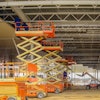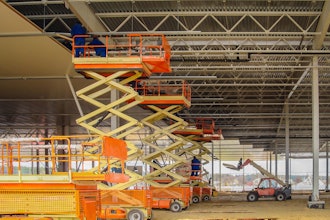If you have approached energy efficiency in the past but are unsure as to the next step in making your processes less energy-intensive, this survey will show you what your customers are thinking.
The 2010 Energy Intelligence Competitor Breakdown aims to give you a cross-sectional view of what other manufacturers are looking at when trying to make their operations more energy efficient. Readers weighed in on which aspects of their current processes are more inefficient, which they would like to replace in the future, what equipment purchases they have made in the last six months, and their achieved ROI. If you have approached energy efficiency in the past but are unsure as to the next step in making your processes less energy-intensive, this survey will show you what your competitors are thinking.
How Important is Energy Efficiency?
Figure 1
In this downtrodden economy, capital investment purchases are more difficult to justify, particularly when many manufacturers are simply struggling to hold on and ride out the worst. At the same time, other firms are looking at the recession and the temporary dip in American manufacturing prowess as an opportunity to reconfigure their old processes and equipment in order to rebound from hard times with more vigor. 51.6 percent of respondents to our Energy Intelligence Competitor Breakdown survey said that they were looking to purchase new equipment — based on its energy efficiency in particular — within the next six months. While investment seems to carry a narrow majority, the 48.2 percent portion of readers who are not investing in new equipment shows there is still a hesitation to jump into capital purchases. But just because a company is unable to presently invest in new technology does not mean they have not analyzed their own operational efficiencies, and are not ready to move forward when the economy recovers.
As seen in Figure 1, a majority of respondents stated that energy efficiency is an important issue in daily operations, but is outweighed by increasing uptime or ensuring employees have a safe and healthy environment in which to work. While 28.7 percent stated that energy efficiency is regularly shuffled down the “to do” list, there is no more concrete proof to the universal importance of efficiency to American manufacturers than the overwhelming number — 95 percent — of those who are consistently considering the topic. Even if there are no funds available to purchase new equipment now, most manufacturers are analyzing their current methods and components to find what needs replacing in the future, and where its most troublesome areas are. Having a well-researched plan for the future, whether or not it can be executed in the next six months or year, is perhaps more important than the purchase itself.
What is so Inefficient, and Why?
The worst offender is clear: plant environment systems. 38.7 percent of survey participants said the various systems that make manufacturing more comfortable and safe — such as HVAC systems, lights, fans, and central vacuum systems — are the most wasteful. So long as American winters get cold, or the summers hot, or the winter nights longer, there will be an extensive need for these energy-taxing systems, which can be forgotten as manufacturers seek to improve their actual production lines. Older HVAC systems are woefully inefficient compared to newer technology, and the incandescent bulbs of the past are still very much in usage around the country.
As long as the system produces cold air, or heats in the winter time, its operational efficiency is rarely scrutinized as motors or drives, which received 21.3 percent of the votes. Pneumatics took the second spot with 27.6 percent of responses, proving that compressed air can easily up the utility bill. Whether this is due to operator malpractice, such as leaving air compressors on while they are not in use, or due to leaks that can rack up costs over a long period of time, many manufacturers are considering their pneumatic systems as potential sites for energy efficient upgrades.
Just over 50 percent of respondents said that their machines are inefficient simply because they cannot be replaced at the moment; this number coincides closely with the number of readers who are not considering capital investment in the near future. Whether or not a purchase is on their mind, or even possible, manufacturers are clearly analyzing each component of their process for the amount of energy it utilizes — a simple step that any company should take. Some basic analysis places the well-researched company above its competitors when it finally does move to correct some of its most inefficient systems.
While many processes can be overhauled by the replacement of select components, other manufacturing operations are simply exhaustive. Forging, for example, uses a great deal of energy, and no amount of capital investment will make it truly “green.” 21 percent of the survey’s respondents said this was an ongoing issue in their manufacturing facilities, and while not everyone deals with the same processes, the advice in moving forward is clear: Upgrading smaller components can help squeeze energy efficiency out of almost any energy-hungry process. One cannot change the amount of energy a forge requires, but they can replace old conveyor motors with newer, more efficient models.
Figure 2
What are Your Competitors Buying?
The answer is clear: more than 50 percent of respondents who have purchased new equipment recently said they upgraded their existing plant environment systems (Figure 2). Once again lighting, fans, and other associated environmental components proved to be on the forefront of manufacturers' minds, and it is no surprise, considering they were also perceived to be the least efficient of all a facility’s components. For the most part, these are cheap and simple component-based solutions — such as lighting or ceiling fans — to an energy inefficiency problem, and do not require downtime of manufacturing processes, making these attractive possibilities for those looking to upgrade their facilities. Many manufacturers expressed a desire to update their aged HVAC systems, as new technology has increased efficiency by leaps and bounds, but hesitate to make such a large investment in the current recession.
Motors and drives, particularly electric ones, are well-known as the single most wasteful component of many manufacturers’ processes. Electric motors soak up roughly half of the electric energy our nation produces, and manufacturers are certainly to blame for a large portion of that amount. It comes as no surprise, then, that 35.1 percent of manufacturers sought out new motors and drives in an effort to upgrade their existing facilities. Considering their nationwide energy usage, electric motors certainly fit within the category of “naturally wasteful,” but that does not mean forward-thinking manufacturers are able to squeeze the most efficiency out of an inefficient component.
Interestingly, only 20.2 percent of respondents said they had upgraded their pneumatics components in recent history, despite being generally conceived as less efficient than motors and drives. This could be due to costs. While a new high-capacity air compressor can cost well above $10,000, a handful of new conveyor drives could be a significantly smaller investment. And the cost of an equipment investment is not proportional to its energy-efficiency; only a thorough analysis of what each component costs will prove that one purchase is better than another. No single suggestion will work for all manufacturers. For those who have aged and inefficient air compressors, the ROI in purchasing a new model could be significantly quicker than a few new electrical motors or drives. On the other hand, companies with already-efficient production equipment may benefit most strongly from ambient components, such as HVAC or fans.
Performance within material handling equipment and MRO supplies (17 percent and 16.7 percent, respectively) is nothing to scoff at, either — both represent the wide spectrum between low- and high-cost investments and small to large returns on energy efficiency. But in a world where return on investment (ROI) is critical, how are manufacturers reeling in lower costs on their recent purchases?
Where to Go Forward
Figure 3
Many manufacturers are finding quick ROI with new equipment purchases, with 42.4 percent meeting that return in just one to two years (Figure 3). With such a large overlap between this quick ROI and the focus on upgrading plant environment systems, one can make a fairly definitive three-part conclusion: plant environment systems are the least energy efficient, are the most often purchased investments, and produce a relatively quick ROI. While these systems cover a wide variety of components — the previously mentioned lighting and fans, in addition to industrial vacuums, water treatment, and roofing — it is clear your competitors have their minds, not to mention their pocketbooks, on these investments.
Other firms reported an ROI of two to four years. This could be associated with the large portion of respondents who said their recent purchases weren’t solely based on its energy efficiency. Even when updating old equipment due to failure or the advent of newer technology, manufacturers can always seek out a more energy efficient product. In contrast, those companies achieving an ROI in less than a year are likely focusing on the previously-mentioned smaller upgrades, notably lighting. If you are looking to turn around your investment in the shortest period of time, it never hurts to think small — one light bulb may not change much, but a whole facility’s worth can make a significant dent in the electric bill.
And if manufacturers could implement one technology into their facilities, despite the costs? A large portion of respondents suggested a variety of sustainable energy solutions, including converting methane gas to electricity, onsite biomass-based energy production, and the more traditional solar or wind power. Other creative solutions include recapturing heat from forging operations, producing nitrogen in-house, and replacing natural gas ovens with UV lamps.
And while these might be pie-in-the-sky ideals for many manufacturers, the proof is in the pudding: You can be sure your competitors are aware of their operational inefficiencies, even if they are unable to act in the current economic turmoil. If the opportunity to heavily invest in new equipment is not currently available, perhaps a simple mantra is in order: buy small, but always plan big.
And if your company is in the position to make an expansion or investment over its current technology, the time could not be better to prepare for the eventual economic recovery. With many manufacturers finding an ROI of one to two years on equipment investment, a forward-thinking purchase will ready your operations to be more efficient, cheaper, and more reliable when business hits its stride once more.






















